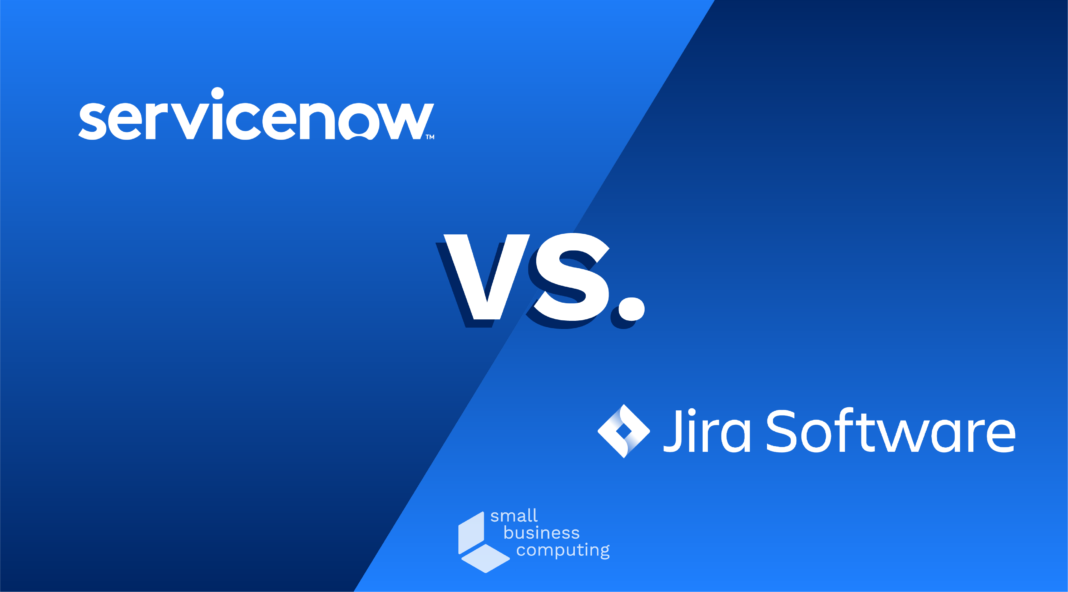Jira Service Desk and ServiceNow are software platforms that started their lives as something other than a field service management (FSM) solution, but for many companies these tools work perfectly to organize, track, and approve FSM workflows.
Compare ServiceNow vs. Jira
- Overview of ServiceNow
- Overview of Jira Service Desk
- Major features in common between ServiceNow and Jira
- Major differences between ServiceNow vs Jira
- Choosing the best field service management software
Overview of ServiceNow
ServiceNow, which operates completely in the cloud, streamlines and automates business functions like field service management.
Based on a ticketing system, it’s a platform as a service (PaaS) solution, originally designed as an IT Service Management tool but with a robust and adaptable FSM component. In fact its strengths in other areas makes it a serious contender in all kinds of industries that need ticket-based workflow functions.
Because ServiceNow was built from the ground up as a cloud-based product, integrations with other platforms are a lynchpin of its operation, many other tools augmenting or extending its functionality.
Something to keep in mind, however, is that according to some of the user comments found online is that ServiceNow isn’t quite as interactive as Jira, but what it lacks in a visual sensibility and an ease-of-use learning curve, it makes up with flexibility.
Overview of Jira
Coming from online workflow platform powerhouse Atlassian, Jira is more or less an add-on built on top of Atlassian’s products and is closely connected to the company’s ecosystem of other solutions. That means the number of third party applications that connect with it is mind boggling – the Atlassian marketplace offers over 2,400 of them.
Jira started life as a bug testing tracker and traffic management tool for software and mobile apps, but it’s so flexible as part of the Atlassian product and platform family it’s found homes in every other industry and use case, including field service management. Today Jira is a highly customizable and proven project management system that will make you more agile than ever.
Major features in common between ServiceNow and Jira
While both of these tools are built as ticketing frameworks, they are used by many companies as full field service management solutions. But the feature both platforms have in common that has the most impact on usability is the wealth of integrations they offer. As cloud computing products and platforms proliferate and grow, easy connectivity to other business applications is, in many ways, more important than the core feature set a product ships with.
Jira even offers a powerful REST API, which gives it even more reach for extended use, as your development team can customize automated calls from internal apps.
Major differences between ServiceNow vs Jira
Like other platforms and tools from industry leader Atlassian, Jira has a well thought out interface that’s easy to access and use through a web browser of any size on any device. And while ServiceNow is no slouch in user interface (UI), it was released – and evolved – more as an enterprise-level tool. That means if you’re a small business there will be accessibility issues as the interface and the all information it tries to convey at once might overload you somewhat.
It’s also very hard to look past Jira’s price of $10 per month for three users and $20 for four or more. In line with its enterprise target market, ServiceNow starts at an annual price a thousand times that: Your yearly bill for the lowest service tier will be $10,200.
That’s a steep increase, but it’s within the reach of even many small businesses, so don’t discount ServiceNow out of hand – there’s a good reason it commands such a large slice of the FMS market. ServiceNow contains the means to share and action information along workflows by customers, users and employees very easily, all of it very clearly notated and explained to whoever needs to access it.
ServiceNow’s learning curve is steeper, but once you get there it’s very powerful. It contains a lot of features out of the box that Jira doesn’t such as customer surveys, incident management, a full knowledge base/FAQ engine, multi-site support and the means to input and share service level agreements.
Choosing the best field service management software
On the surface it seems like ServiceNow is suited to larger organizations, and if you have several dozen or hundred agents it’ll indeed seem more applicable to your circumstances and needs.
But it offers things Jira doesn’t (and vice versa), so make sure you plan out exactly what you need in a field service management tool – do you need to keep track of vehicles or stock, for instance? How much do you want customers to be able to review or action their own parts of the supply chain? The answers to those and many more questions have to arise organically out of the way you want to do things, and they’ll show you the path.


